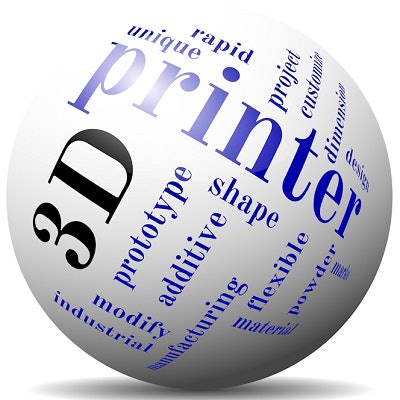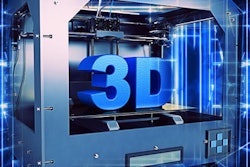
Want to print teeth for your patients? Dentists discussed how 3D printing is changing dentistry at the recent 3DHeals 2017 conference in San Francisco.
Maybe printing teeth and dentures is just beyond our capabilities at present, but as the cost comes down it could become a reality in the near future. As dental 3D technology advances, printing experts point out that the 3D printing of surgical guides is currently available and helping to improve implant surgery. Dentists at the conference shared tips on how practitioners can learn more about and use this emerging technology.
"The DIY segment in digital dentistry is picking up a lot of momentum, as we are able to do things that were not really possible just a couple of years ago," Ivan Chicchon, DDS, a prosthodontist in Stockton, CA, who presented a hands-on dental workshop at the conference, told DrBicuspid.com. "The affordability of high-quality 3D printing and the availability of good open-source software that we can use for dental applications are opening up many doors."
Dentists as makers
This was the first time that the 3DHeals conference has taken place, according to its organizers, who said they may put on another one in 2018. Presenters and attendees included more than 300 dentists, physicians, engineers, designers, entrepreneurs from start-up companies, and Silicon Valley venture capitalists. Presentations covered how dentists can use 3D printing to improve patient care and the challenges of adopting the technology.
 Ivan Cicchon, DDS, a prosthodontist from Stockton, CA, gives a presentation at the 3DHeals conference.
Ivan Cicchon, DDS, a prosthodontist from Stockton, CA, gives a presentation at the 3DHeals conference.During Dr. Chicchon's workshop, he walked dentists, dental students, and company representatives through the use of Blue Sky Plan treatment planning software (Blue Sky Bio) for 3D printing surgical guides. His website provides videos and information about creating dental implants.
Nabeel Cajee, DDS, a comprehensive dentist and oral surgeon practicing in both Stockton and Manteca, CA, advised dental students and practitioners to investigate the 3D printing arena on their own. A 2015 dental school graduate and an adjunct faculty member at the University of the Pacific Arthur A. Dugoni School of Dentistry in San Francisco, he moderated a panel on 3D printing in dentistry at the conference.
"Start tinkering," he said in an interview with DrBicuspid.com. "Start getting familiar with the software."
These skills aren't being taught in dental schools, even though more and more dentists are placing implants and performing computer-guided surgery, he noted. Dr. Cajee recommended identifying people doing interesting things, learning from them, and watching their YouTube channels.
"There is a gap between what we want to provide and what we are trained to provide," he said.
Nima Massoomi, MD, DMD, an oral and maxillofacial surgeon in San Francisco who spoke on Cajee's panel, explained that 3D printing is allowing surgery to become much more predictable, minimally invasive, and aesthetically appealing.
"The accuracy is getting tighter and tighter," he said.
Current uses
Dental labs currently use 3D printers to print wax templates of prosthetics that they use to fabricate the final prosthesis.
"In the very near future, 3D printing will be used to make temporary crowns, bridges, and dentures," Dr. Chicchon said, noting that this is a year or so away.
“The affordability of high-quality 3D printing and the availability of good open-source software that we can use for dental applications are opening up many doors.”
He expects that early adopters of this technology will be dental labs.
"Dentists like me, who like to play with this technology and pioneer the digital techniques, will adopt this early as well," Dr. Chicchon said.
For now, many dental prosthetics are made via subtractive manufacturing, he explained, with crowns and bridges commonly milled from solid blocks and then processed before being placed in a patient's mouth.
"3D printing has not been used for making prosthetics because of some limitations in the material and resolution, but I think this will be changing very soon," he said. "Formlabs has announced that they will be releasing a 3D printable denture material that will be able to be delivered as a prosthesis for patients. For me, this changes everything. Prosthetics that you can install in a patient's mouth make printing so much more practical. We will soon see dental laboratories offering this technology to their doctors."
Currently, Dr. Chicchon's office offers a same-day full set of teeth or all-on-four protocol with a dental lab making the full set of teeth installed on the day of surgery.
"It's just a matter of time before I start providing this service with a fully 3D-printed workflow," he said. "I'm really excited about this."
Barriers to technology adoption
Dentistry faces some of the same barriers to the adoption of 3D printing technology that affect the rest of the medical field. These were discussed at the 3DHeals conference during the panel discussion and also in sessions about applications of 3D printing technology in other areas of medicine.
Issues related to reimbursement, cost, lack of training of dentists in computer-aided design, technical challenges, and scarcity of software specifically designed for dental applications can get in the way, he said. Nevertheless, hacking the software to do new things and collaborating with software companies can help advance use of the technology, according Dr. Cajee.
"This is the future," he said. "I want to be a part of it."



















